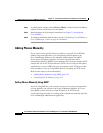
Chapter 2 Preparing to Install the Cisco IP Phone on Your Network
Guidelines for Configuring Ports on Cisco IP Phones
2-8
Cisco IP Phone Administration Guide for Cisco CallManager 3.2, Cisco IP Phones 7960/7940/7910
78-10453-04
Use the following information to choose a power source for the phone:
• If you plug a phone into the optional power supply before plugging it into the
network, the phone is powered by the power supply.
• If you then unplug the phone from the power supply, the phone resets. If the
switch port is configured for 10/100 Mbps, the switch recognizes the loss of
power and brings the phone back up.
• If the switch port is configured for 10 Mbps only, then you must unplug the
network connection and plug it back into the phone for the switch to
recognize the phone’s loss of power.
• If, however, you plugged the network connection into the phone before you
plugged in the power cord, the phone receives power through the switch, and
unplugging the power cord will not bring down the phone. If the switch
reboots, the phone will then be powered by the power cord.
Redundancy Feature
For redundancy, you can use the Cisco AC adapter even if you are using inline
power from the Cisco Catalyst switches. The Cisco IP Phone can share the power
load being used from the inline power and external power source. If either the
inline power or the external power goes down, the phone can switch entirely to
the other power source.
To use this redundancy feature:
1. Set the inline power mode to auto on the Cisco Catalyst switch.
2. Connect the unpowered Cisco IP Phone to the network.
3. Connect the external power supply to the phone after the phone powers up.
Configuring the Handset, Headset, and Speakerphone
Cisco IP Phones enable you to connect a headset to them or use the built-in
speakerphone to make calls rather than the standard handset. These sections
provide you with additional information about configuring these options:
• Connecting a Handset to a Cisco IP Phone, page 2-9
• Connecting a Headset to a Cisco IP Phone, page 2-9
• Disabling the Speakerphone Feature, page 2-10


















